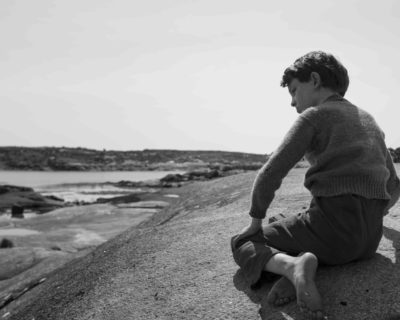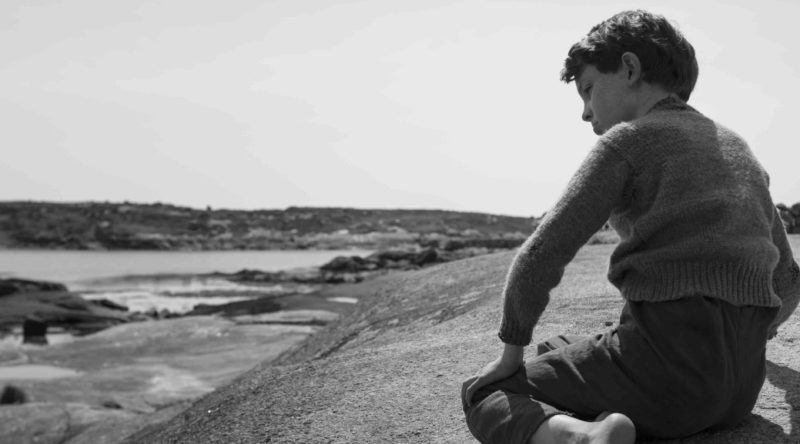INTERVIEW: Irish folksinger Joe Heaney and his ‘Song of Granite’

It’s believed that Irish folksinger Joe Heaney knew 200 sean nós, or traditional Irish songs unaccompanied by music. He learned the lyrics and stories of these selections over the course of his life in the 20th century, picking up on details in his childhood on the western coast of Ireland and continuing all the way to his job as a doorman in New York City and playing the Newport Folk Festival in 1966.
The singer’s remarkable life is the subject of a new documentary/fiction film from director Pat Collins. Now playing at New York City’s Film Forum, the interesting biopic mixes several methods to tell stories and songs from Heaney’s life, which spanned from 1919 to 1984.
Recently, Hollywood Soapbox exchanged emails with Collins about the new film, which is distributed by Oscilloscope Laboratories and is Ireland’s official submission for Foreign Language Film at the Academy Awards. Questions and answers have been slightly edited for style.
What inspired you to cinematically tell a story about Joe Heaney?
Singing for me is important, and it was all around me growing up. And for me making a film about Joe Heaney was a way of making a film about singing and how important I feel singing is. Heaney was a mysterious character who lived for singing. Sometimes it seems like he carried the tradition on his back, from place to place and country to country. This particular style of singing sean nós (meaning old style) is a great art form, and Joe Heaney has helped make it into a more widely recognized art form.
There have been two books written about him. There was a documentary about him in the ’90s. There’s a music festival in his honour in Galway, and now I’ve made a film about him. So [he] must have something?
Did the decision to include both documentary and fiction filmmaking come immediately?
Because I started as a documentary filmmaker, it feels natural to me to include everything that is at your disposal. If you’re making a documentary film — let’s say an impressionistic portrait of a writer — you can draw on music, poetry, archive, photographs, illustration, super 8, 16mm film, video, anything that helps you get across the atmosphere of the film that you are trying to make. So it’s natural for me to think of archive even when I’m making a film that is primarily drama.
A lot of the archive that appears in the film was already written into the script, and I always felt it was important for us to show the real Joe Heaney alongside our dramatic versions of him. Also it creates a charge — the challenge sometimes is making the drama as evocative as the archive. But if you think of Mirror; let’s say the way archive is used in that is so moving and powerful.
What were some of the unique challenges of the production?
I’ve always found Joe Heaney’s singing mesmerizing. I’ve always found it meditative, and when I’m listening to him, I feel inside the music. And that was what I was trying to capture in the film, too. The single greatest worry I had was would we be able to capture the singing in a way that transports the viewer. Could we do it right so the viewer could get lost in the singing?
For me, the importance of getting the performances right was central. There is a scene in the middle of the film where Micheál O’Confhaola sings an Irish language song called ‘An Tiarna Randall’ — unaccompanied and with great intensity and feeling. It’s just one take in a crowded bar — and for me it is spellbinding. I can say that because I almost don’t feel responsible for it. He sang so well that for me it’s meditative, it’s moving and it transports you to another zone.
I helped create that, but I was not fully responsible for it. When we had shot that scene, I was very relieved because another day so many things could conspire against us. The stars were aligned that day.
How important was authenticity when portraying Irish folksinging?
It was important for me that real singers had to sing the songs in real time. It was important that the viewer would become immersed in the song — along with the singer — and that it would feel like you were there in the room with the singers and with the listeners. I don’t think you can do that with, for instance, an actor miming the singing. It just wouldn’t work. The viewer may not be able to articulate it, but they would be able to feel it. A lot of thought went into the song selection and who would be the right singers. It takes years to get right, and there are no shortcuts.
What do you hope is the audience’s takeaway from the film?
I hope people will appreciate the music and the singing because I feel it’s universal. I’d like them to go further into discovering Joe Heaney’s music and also to look around their own place to see what’s going on around them. I’d like them to feel like they discovered something. That’s what I go to the cinema for. It’s not necessarily to be entertained. It’s to learn something new and feel something new — and maybe discover something. That’s very ‘grand’ in a way, but that’s what I look for myself. So I should at least try to match that.
By John Soltes / Publisher / John@HollywoodSoapbox.com
Song of Granite, directed by Pat Collins, is currently playing New York City’s Film Forum. Click here for more information and tickets.

